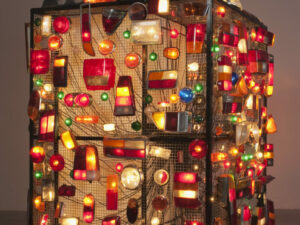On 25 May, 1963, Dan Flavin developed his first mature work, the Diagonal of Personal Ecstasy, dedicated to Constantin Brancusi, and consisting of a single fluorescent lamp installed diagonally on a wall. From then onwards, Flavin worked exclusively with commercially available fluorescents to develop his own form of minimalism, creating what he termed ‘situations’ composed entirely of light and colour, which both interact with the surrounding architecture and mediate the viewer’s perception and awareness of space. Many of these works fall into several recurring formats, and for this exhibition, David Zwirner, New York, draws together a selection of Flavin’s ‘corner’, ‘barrier’ and ‘corridor’ works from the late 1960s and early 1970s.
On view is a notable two-part ‘barrier’ in yellow and green dedicated to the artist’s wife, untitled (to Sonja), 1969, which was first shown as Flavin’s contribution to the group exhibition Spaces at The Museum of Modern Art, New York, in 1969-70. Flavin’s installation comprised rectangular units of coloured fluorescent tubes that formed two interior barriers from the corners of the entrance wall to the far end of the room. This is the first time it has been recreated since that landmark MoMA exhibition.
Also featured is a rare barrier that shines white fluorescent light into an empty room while rendering it inaccessible: untitled (to Dorothy and Roy Lichtenstein on not seeing anyone in the room), 1968, which has not been exhibited since 1970. The title is a reference to a 1961 painting by Roy Lichtenstein: I can see the whole room!…And there’s nobody in it!
A ‘corridor’ in yellow and pink fluorescent light from 1972-75, untitled (to Barry, Mike, Chuck and Leonard), is also presented. It divides an architectural passageway into two mutually inaccessible, obstructed fields of colour and light, playing on the viewers’ cognitive and physical perception of distinctly coloured, opposite ends of the same space.
Other works demonstrate the artist’s less-known use of circular light fixtures: untitled (to a man, George McGovern) 1 and 2, both from 1972, succinctly illuminate the corners of a given space with wallmounted triangular constructions of cool and warm white circular lamps.
Dan Flavin, Corners, Barriers and Corridors, until 24 October, David Zwirner 537 West 20th Street New York, NY 10011.
More information can be found at www.davidzwirner.com.
Follow us on Twitter @AestheticaMag for the latest news in contemporary art and culture.
Credits
1. untitled (to Barry, Mike, Chuck and Leonard), 1972-1975. © 2015 Stephen Flavin/Artists Rights Society (ARS), New York.





